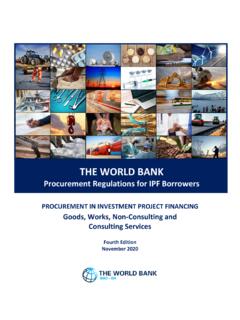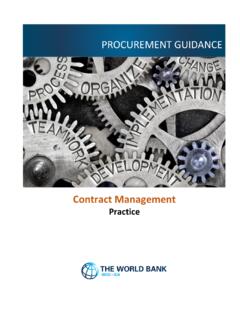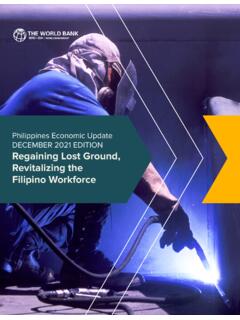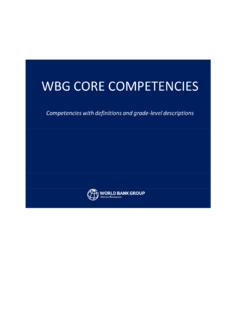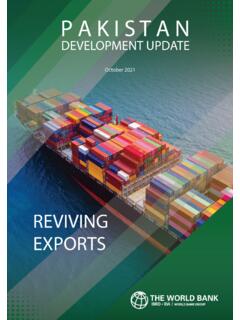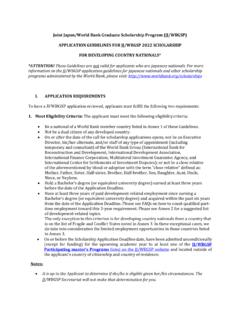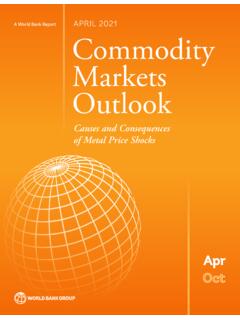Transcription of CREDIT SCORING APPROACHES GUIDELINES - World Bank
1 CREDIT SCORING . APPROACHES GUIDELINES . 2019 The World Bank Group 1818 H Street NW. Washington, DC 20433. Telephone: 202-473-1000. Internet: All rights reserved. This volume is a product of the staff of the World Bank Group. The World Bank Group refers to the member institutions of the World Bank Group: The World Bank (International Bank for Reconstruction and Development);. International Finance Corporation (IFC); and Multilateral Investment Guarantee Agency (MIGA), which are separate and distinct legal entities each organized under its respective Articles of Agreement.
2 We encourage use for educational and non-commercial purposes. The findings, interpretations, and conclusions expressed in this volume do not necessarily reflect the views of the Directors or Executive Directors of the respective institutions of the World Bank Group or the governments they represent. The World Bank Group does not guarantee the accuracy of the data included in this work. Rights and Permissions The material in this publication is copyrighted. Copying and/or transmitting portions or all of this work without permission may be a violation of applicable law.
3 The World Bank encourages dissemination of its work and will normally grant permission to reproduce portions of the work promptly. All queries on rights and licenses, including subsidiary rights, should be addressed to the Office of the Publisher, The World Bank Group, 1818 H Street NW, Washington, DC 20433, USA; fax: 202-522-2422;. e-mail: TABLE OF CONTENTS. ACKNOWLEDGMENTS III. EXECUTIVE SUMMARY V. ABBREVIATIONS AND ACRONYMS VII. GLOSSARY IX. POLICY RECOMMENDATIONS XI. 1. BACKGROUND 1. Introduction 1. Evolution of CREDIT SCORING 1.
4 CREDIT SCORING Definitions 3. CREDIT SCORING Use Cases 4. Regulatory Developments 4. 2. DATA 9. Introduction 9. 3. CREDIT SCORING METHODOLOGIES 15. Introduction 15. Traditional CREDIT SCORING Methods 15. Artificial Intelligence and Machine Learning in CREDIT SCORING 16. Other Techniques Related to CREDIT SCORING Methods 19. Understanding and Interpreting CREDIT SCORING Models 20. 4. OPPORTUNITIES, RISKS & CHALLENGES 23. Introduction 23. Opportunities 23. Risks 24. Challenges 27. 5. REGULATORY OVERSIGHT 29. Introduction 29.
5 Summary of Key Regulatory Frameworks 29. 6. TRANSPARENCY AND DISCLOSURE 33. CREDIT SCORING APPROACHES GUIDELINES I. 7. CONCLUSION 35. Generalised Additive Models 41. Decision Trees 41. REFERENCES 37. APPENDIX A: CREDIT SCORING METHODOLOGIES 41. Generalised Additive Models 41. Decision Trees 41. Random Forests 41. Gradient Boosting 42. Support Vector Machines 42. Deep Neural Networks 42. K-Means Clustering 43. APPENDIX B: MODEL-AGNOSTIC INTERPRETABILITY TECHNIQUES 45. Partial Dependency Plots 45. Individual Conditional Expectation Plots 46.
6 Global Surrogate Models 46. Local Interpretable Model-Agnostic Explanations 46. LIST OF BOXES. Box : What is a CREDIT Scorecard? 3. Box : Basel II Summary18 (BCBS, 2003) 5. Box : IFRS 9 Summary 6. Box : Types of Data Used for CREDIT SCORING 11. Box : Use Case Grab Financial and the use of Alternative Data 12. Box : Consumer Rights GUIDELINES by the World Bank 13. Box : Machine Learning for CREDIT SCORING 17. Box : Use Case Colendi 20. Box : Use Case Nova CREDIT 24. Box : Discrimination and Biases 25. Box : Equifax 2017 Case 26.
7 LIST OF FIGURES. Figure : Deep Neural Network 43. Figure : Example of a Partial Dependence Plot 45. Figure : Example of Individual Conditional Expectation Plot 46. LIST OF TABLES. Table : Differences between CREDIT Scores and CREDIT Ratings 4. Table : Types of Data Used for CREDIT SCORING 10. Table : Overview of Financial Stability Board 29. Table : Overview of Basel Committee on Banking Supervision 30. Table : Overview of European Data Protection Board 31. Table : Overview of the European Securities and Markets Authority 31.
8 Table : Overview of the Federal Reserve System 32. II TABLE OF CONTENTS. ACKNOWLEDGMENTS. This guideline is a product of the International Developing and Implementing Intelligent CREDIT Committee on CREDIT Reporting (ICCR) and the SCORING (Hoboken, NJ: Wiley and Sons; 2017), World Bank Group (WBG). The guideline was as well as useful discussions with participants at prepared by Dr. Terisa Roberts (independent the 2018 Singapore Fintech Festival and with the consultant) and benefited from the valuable Data Science team at the Monetary Authority of contributions from Leon Francisco, Umair Ahmed, Singapore.
9 And Thai Duy Trinh of the SAS Institute. The ICCR would also like to thank the Chairman The document benefited from a consultation of the ICCR, Sebastian Molineus and Secretariat process with ICCR CREDIT SCORING Working Party, members Luz Maria Salamina and Collen Masunda plenary members and representative organizations, for guiding the process. The Committee also and external peer reviewers. The report further acknowledges the managerial oversight by Mahesh benefited from valuable inputs and reviews by Uttamchandani, the incoming ICCR Chair.
10 Naeem Siddiqi, author of CREDIT Risk Scorecards: CREDIT SCORING APPROACHES GUIDELINES III. EXECUTIVE SUMMARY. CREDIT SCORING is widely understood to have The opportunities of using innovative methods for immense potential to assist in the economic growth CREDIT SCORING include greater financial inclusion of the World economy. Additionally, it is a valuable and access to CREDIT , improvement in the accuracy tool for improving financial inclusion; CREDIT access of the underlying models, efficiency gains from for individuals and micro, small, and medium the automation of processes, and potentially an enterprises; and efficiency.
